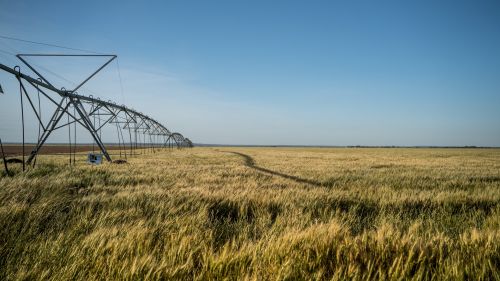Farmer-Led Irrigation for Agricultural Intensification

Michael Tiboris discusses the challenges of feeding and nourishing a rapidly growing global population in the face of water scarcity.
Agricultural Intensification and Water Stress
More food requires more water; more nutritious food requires a lot more water. The basic challenge for the global food system is feeding a larger and generally wealthier population—which needs a more diverse and nutritious diet—on water resources that are already over-extended in high production areas. This challenge can be met but it is more complicated than simply finding more water to grow the food we need. Even though agricultural production is rising, and currently produces enough total calories to sustain a growing global population, hunger is still very prevalent in many regions.
This strongly suggests that much of the needed food production will have to come from agricultural intensification in the low-and-middle-income countries (LMICs) where the food needs are greatest. Poverty and food insecurity have persisted in Asia and Africa despite the fact that up to 90 percent of the population in some food insecure countries are farmers. These farmers are nearly universally smallholders working less than five acres without modern mechanized agriculture systems. Improving water management practices for these farmers would simultaneously reduce hunger, raise farmer incomes, and build sustainable farming infrastructure.
There is little extra water available in high production places, and while gains can be made in efficiency, it is clear that feeding the planet will require significant agricultural intensification. Water scarcity presents a tight constraint on production, however. Twenty-eight percent of the world’s food is grown in highly water-stressed places. The World Bank predicts a 40 percent gap between freshwater supply and demand by 2030. In already intensively farmed places, new water supplies cannot generally be economically produced and there is little available land to pull into production.
Bringing Water to Smallholders
The historical water-related challenge for smallholder farmers is variability. Most of the world’s agriculture is rain-fed, meaning that farmers’ incomes and food security are at the mercy of the weather. There are very low rates of water catchment in Sub-Saharan Africa, for instance, but very high seasonality which means that it is not possible for farmers to grow valuable crops during the dry season. Climate change is a major threat to farmers that do not have ways to capture and retain water for dry seasons. Irrigation improves crop yields two to three times over that of rain-fed agriculture, and it allows farmers to grow additional harvests during the year. As a result, it can play a pivotal role in poverty alleviation and hunger reduction.
Even though Sub-Saharan Africa has adequate seasonal rainfall and fairly plentiful groundwater resources, the lack of infrastructure for retention and irrigation has prevented intensification. Meanwhile, many African countries are net food importers, leaving them especially vulnerable to food price fluctuations and sudden shocks to production, such as droughts or major storms. Given that we can expect continued pressure on agricultural productivity globally, there are a few clear responses, such as improvements in productivity which reduces water loss and increases the volume and value of crops produced with the same or less water.
However, there is the most potential for immediate growth in expanding irrigation to provide more year-round water and resilience against changing weather patterns. In Sub-Saharan Africa, only about 5-7 percent of cultivated land is currently being irrigated, in contrast to 37 percent in Asia. However, cost remains a barrier for small farmers. The cost of bringing cultivated land into irrigation in Sub-Saharan Africa is $2000-$4,000 for a small-scale system and as much as $9,000-$15,000 for larger systems. This is higher than global averages and far beyond the realm of possibility for many farmers.
High rates of farmer poverty have led to a historical preference for large state-led irrigation schemes, including centrally managed dam infrastructure and canal systems. Assessments of the extensive efforts to fund major centralized infrastructure projects at the end of the 20th century, however, revealed tepid results. By the World Bank’s own assessments, the majority of its large-scale irrigation infrastructure projects in Africa failed to meet expectations, suggesting a need to pursue other irrigation options.
Farmer-Led Irrigation
The World Bank describes farmer-led irrigation as cases in which “farmers drive the establishment, improvement, and/or expansion of irrigated agriculture.” The emphasis in efforts to expand irrigation in LIMCs has recently begun to shift toward finding ways to fund and support the adoption of distributed, small-scale, and private-sector supported irrigation practices. The success of farmer-led irrigation expansion is fundamentally dependent on targeting investment and technical support on the practices that farmers are already inclined to adopt and which can be scaled-up over time.
For instance, shallow groundwater pumping for irrigation is potentially available to many farmers in Sub-Saharan Africa. For adoption to make financial sense, low-cost and easy to repair pumping and sprinkler technology must be made available, ideally through the private sector with support by thoughtful grants and organizational support for farmer groups. Additionally, there must be investments made in receiving market infrastructure—e.g. roads, trustworthy shipping, storage, and market-price information—without which farmers have little reason to improve production. The incentive to adopt available technology depends on the existence of a place to sell what farmers produce. Further, management of shared water resources and irrigation systems should be organized and administrated by the farmers who use the resource and who best understand their needs and capacities.
All of these things require significant financial investments, as well as investments in education and technical support. At the 2018 African Green Revolution Forum, a coalition of African agricultural ministers, multilateral financial institutions, nonprofits, academics, agribusiness representatives, and members of farmer organizations adopted the Kigali Joint Statement on Farmer-Led Irrigation. This document is intended to serve as the groundwork for major new efforts to expand private and public support for scaling up smallholder irrigation opportunities in Africa. Since then, other influential groups, such as the Malabo Montpellier Panel and the Daugherty Water for Food Global Institute have highlighted farmer-led irrigation as a leading strategy for reducing food insecurity and poverty.
While there will always be a place for large-scale irrigation schemes, concerted investment in farmer-led irrigation have the potential to reach tens of millions of smallholders for whom such projects are untenable.
The Challenges for Scaling Farmer-Led Irrigation
Strengthening irrigation access for African farmers is key to increasing agricultural productivity in the region. That said, it is vital that intensification and increase use of water resources be managed in a sustainable fashion and with best practices in mind. There are more than 400 million smallholder farmers in Africa. It is the dominant way to make a living in the region, as it is in South Asia. Since the 1970s, however, farmer-managed pump-and-pipe irrigation, largely using groundwater, has added more irrigated land in South Asia than in the previous 200 years. This has allowed India, for example, to make important gains in closing its food security gaps. But this has come with major costs—including critical declines in groundwater availability and growing sub-national conflict over water resources.
Sub-Saharan Africa needs to scale up its distributed farmer-managed irrigation, but India’s experience exposes some potential hazards. Groundwater depletion will result from unregulated and unmonitored expansion of pumping infrastructure. Groundwater is a shared resource and needs to be managed carefully to make it sustainable over time. Directly subsidizing pumping infrastructure and fuel for pumps is risky if farmers become dependent on it, and can lead to over pumping and conflict between farmers.
If these challenges can be anticipated and managed small-scale irrigation expansion will become an especially powerful element of sustainable food security for smallholder farmers.
"Unchartered Waters" Series
- Farmer-Led Irrigation for Agricultural Intensification
- Achieving Food and Nutrition Security in the Face of Water Scarcity
- Growing Cities, Changing Diets
- The Livestock Ladder’s Water Footprint
- Are the Sustainable Development Goals for Water and Food Working Against One An…
- From Chicago to Uganda, Clean Water is Key to Good Nutrition
- The Gendered Burden of Water

